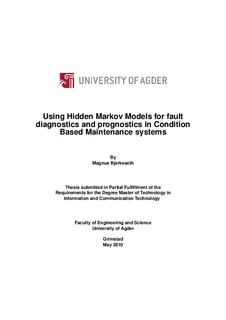| dc.description.abstract | Condition Based Maintenance (CBM)) is a concept that has become more and
more important as the cost, size, and complexity of mechanical components has
increased. As more sensor equipment has become available it has become possible
to measure different kinds of status data, such as vibration, temperature,
or electric current, from different kinds of mechanical components. By using this
status data it should be possible to determine the health of mechanical components,
and determine when they need maintenance, and what parts needs to be
replaced.
Hidden Markov models (HMM) is a statistical model for modelling systems that
evolve through a finite number of states. By using HMMs it is possible to detect
and recognize different kinds of anomalies and errors present in the system. It is
also possible to estimate when the system is going to be in a state where it can
not be expected that the system is going to function properly (error state).
During this thesis I have examined several different ways of applying HMMs to
tasks related to condition based maintenance. HMMs have been tested in their
use in anomaly detection, current state detection, and future state prediction. All
these tasks have been performed with little available training data to demonstrate
how HMMs can still be used even if little prior knowledge about the system is
available.
Tests have been performed to evaluate how well HMMs can detect unknown data
(anomaly detection), determine the current health of the system (current state
detection), and predict the future health of the system (future state prediction).
During all the tests it has also been a focus on how limited training data and
expert knowledge about the system will influence the approach to the problem
and the results of the tests.
Out of all the test that were performed anomaly detection is the task that was least
influenced by the lack of training data or prior knowledge. Current state detection
accuracy was most influenced by the lack of prior knowledge and the quality of
the training data, while future state prediction could benefit from more training
data.
Based on the test it is possible to say that anomaly detection can be performed
with just a minimum of training data. However, prior knowledge about the system
becomes more important because anomalies needs to be classified. Current
state detection requires more training data than anomaly detection. Prior knowledge
about the system is also important when training HMMs to recognize error
states. Future state prediction requires a lot of varied training data to be able to
perform reasonably accurate predictions for new components, that may have a
longer life-cycle than previously seen components. The results of these tests gives an indication about the requirements for training
data, and knowledge about the system where anomaly detection, current state
detection, and future state prediction is being performed. | en_US |
